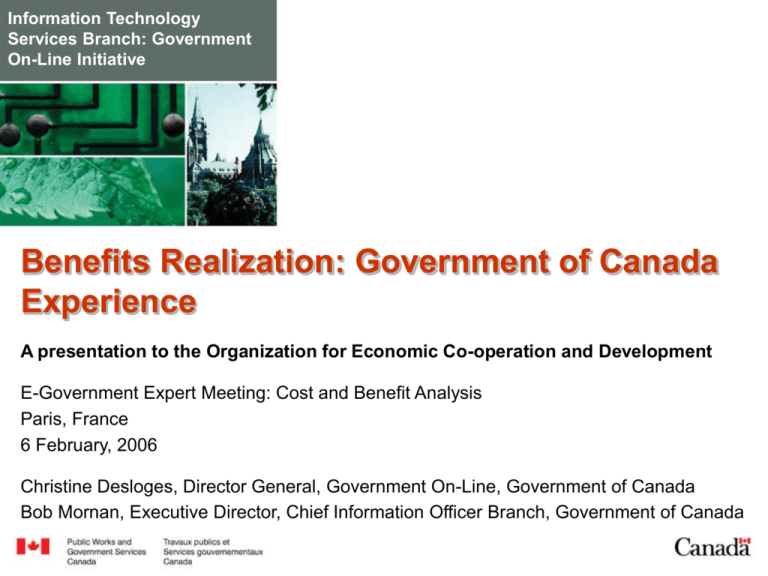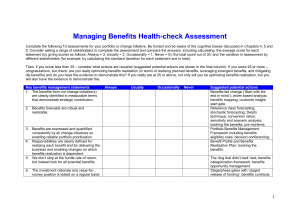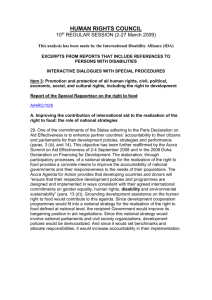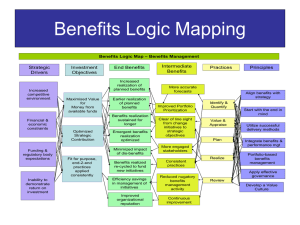Benefits Realization - Treasury Board of Canada Secretariat
advertisement

Information Technology Services Branch: Government On-Line Initiative Benefits Realization: Government of Canada Experience A presentation to the Organization for Economic Co-operation and Development E-Government Expert Meeting: Cost and Benefit Analysis Paris, France 6 February, 2006 Christine Desloges, Director General, Government On-Line, Government of Canada Bob Mornan, Executive Director, Chief Information Officer Branch, Government of Canada Purpose of presentation To share current challenges faced by the Government of Canada (GC) in realizing benefits from IT/IM and e-government projects To present an overview of the GC’s benefits realization methodology and experiences to date To position the discussion for the afternoon session 2 Overview of presentation The problem that the GC is trying to solve Benefits realization principles Benefits realization methodologies – Brief Definitions 1. Enhanced Management Framework 2. Outcome Management Overview of Enhanced Management Framework Overview of Outcome Management methodology Project Management and Outcome Management: Key differences Outcome Management: The Canadian experience Outcome Management: The potential to address challenges for the GC Conclusion Next steps 3 The problem that the GC is trying to solve The GC has committed large sums of money to IT projects based on the promise of a return on that investment; the investment tends to be well managed, but managing the return needs improvement. “Business cases contain untested assumptions masquerading as facts”. The GC requires a benefits realization methodology beyond just providing deliverables to one that: 1. Ensures strategic alignment of outcomes with the business 2. Has broad applicability: – Beyond IT/IM projects – Horizontal initiatives – Prioritizes projects and portfolios 3. Establishes clear accountability 4. Includes ongoing and ex post evaluations – Soft, non-financial benefits 4 Benefits realization principles Benefits realization is the pre-planning for, and ongoing management of benefits promised to be enabled by the successful implementation of an IT/IM or e-government project. Sound project management can only enable a business owner (program) to realize intended benefits Accountability for the realization of intended benefits must rest with the business function, not with the IT project 5 Enhanced Management Framework and Outcome Management: Definitions Enhanced Management Framework (EMF) EMF is an integrated management model that includes processes and key practices designed to ensure that government information technology projects fully meet the needs of the business functions they are intended to support, deliver all expected benefits and are completed on time, on budget and on scope. What are we building? What is the schedule? What does it cost? Outcome Management Outcome Management is a set of methods, processes, tools and techniques for planning, selecting, managing and realizing results and benefits. What problem are we trying to solve? “Start with the end in mind.” 6 Enhanced Management Framework (EMF) In 1996 the Treasury Board Secretariat developed the EMF* which, Is required as part of the submission process (solicitation of funds) for IT/IM projects Focuses on Project Management concepts (IT/IM driven) EMF includes: Cost-benefit analyses (on budget, on time, and on scope) “Gating” progress reporting * For further information on EMF refer to Management of Large Public IT Projects (Treasury Board of Canada, Secretariat, 2000) presented to the OECD in October 26-27, 2000 7 Outcome Management What is an outcome? An outcome (benefit) is the desired result of an initiative undertaken to meet a need or solve a problem (e.g. to reduce gun related crime by 25% within 5 years by implementing a national gun registry system) Outcomes are final results supported by intermediate outcomes (benefits milestones) Background Outcome Management is focused on the outcomes or results side of an initiative or program Outcome Management methodology is a Canadian approach based on internationally recognized project and risk management techniques that has been refined through public and private sector collaborations Outcome Management is an evolving discipline Details Cost benefit analysis is a subset of Outcome Management Outcome Management is the potential link to existing tools or other sources of performance indicators 8 The Outcome Management process Outcome Management Process Stage 0 : Launch Outcome Management Ensure Readiness Stage 1 : Develop Outcome Realization Model Create Initiative Register Create Logic Model Assess Risk Create Outcome Register Stage 2 : Develop Outcome Realization Plan Create Risk Register Create Value Case Create Outcome Realization Plan Stage 3 : Monitor Delivery of Outcomes Stage 4 : Realize and Optimize Outcomes Outcome Implement & Risk Monitoring Create Outcome Management Office Harvest Benefits 9 Outcome Management versus Project Management - EMF: Key differences Project Management - EMF Outcome Management Focus Manage costs, inputs, schedule, resources, deliverables Manage outcomes, benefits, business results, portfolio Deliverables Gantt Charts, schedules, work plan, costs, estimates, progress reports, milestones, issues, earned value, PERT charts, etc. Outcomes maps, outcomes registers, value cases, value assessments, value graph, governance reports or structures Measures of Success On-time, on-budget, delivery of specified change enabler (e.g., system, process), risk management Initiative delivers on promised results, maximized business value of portfolio Processes Project initiation, project monitoring, project close out, etc. Initiative definition, value definition, portfolio selection, results attainment Project / Initiative Is accountable to the business sponsor for project deliverables Is accountable to the Program Manager for project execution Facilitates the value case, ensures that the initiatives benefits are achieved Timeline From project planning to implementation From program planning through implementation to results attainment Outcome Management: The Canadian experience In 2005-06, an examination of 12 GC projects using Outcome Management approach and traditional cost-benefit analysis practices: 8 projects used Outcome Management methodology 4 projects used cost-benefit analysis practices 10 Lessons Learned: 1. Align outcomes with departmental and government priorities 2. Outcome Management can articulate both the business and IT outcomes 3. Engage all stakeholders in the process 4. Outcome management provides flexibility in defining intangible or “soft” benefits 5. Conduct Outcome Management early in the lifecycle 6. Integrate Outcome Management with existing methods, frameworks and tools 7. Successful Outcome Management requires champions, education and communication 8. Outcome Management needs to overcome systemic challenges in government context 9. Cost-benefit analysis useful to document cost and areas for cost avoidances and conducting options analysis 11 Outcome Management provides clear definition of soft benefits 10. Outcome Management: The potential to address challenges for the GC Challenge Outcome Management 1. Strategic alignment with outcomes (business driven) • Focuses on realizing benefits • Identifies activities that contribute to the desired outcomes • Complements and extends the cost-benefit analysis and results in a more robust and comprehensive understanding of the outcomes expected by the initiative 2. Flexibility: - Beyond IT/IM projects - Horizontal initiatives - Prioritizes projects and portfolios • Can be used at the project, portfolio, program and initiative levels • Supports complex horizontal activities that require multiple stakeholders across jurisdictions • Provides information to make adjustments and/or prioritizations at both the portfolio and initiative levels along the way 3. Clear accountability • Supports a clear understanding of how outcomes will be realized and recognized, quantification of outcomes, and the assignment of accountability 4. Ongoing and ex post evaluations: - soft, non financial benefits • Monitors outcomes and their indicators throughout all stages of the Outcome Management process • Provides a process for strong identification and qualification of both hard and soft benefits, presenting a broader view of expected value Conclusion The Government of Canada has faced challenges achieving the benefits of IT/IM and e-government projects through the traditional project management and cost-benefit approaches Outcome Management has the potential to overcome many of the current challenges Outcome Management Focuses on realizing benefits not just providing the deliverables Supports project, portfolio, program and initiative levels Supports an enterprise approach Adjusts and/or prioritizes along the way Details and assigns accountabilities Facilitates on-going and ex post evaluation of “hard” and “soft” benefits 13 Next steps Outcome Management The Government of Canada will: Continue to research and pilot the Outcome Management methodology Explore how Outcome Management can be integrated into existing tools Research how to better cultivate a public sector culture that supports and practices benefits realization evaluations 14 Christine Desloges Bob Mornan Director General, Government On-Line Department of Public Works and Government Services Government of Canada 5th Floor, 2745 Iris Street Ottawa, Ontario Canada K1A 0S5 Tel: (613) 941-4611 Fax: (613) 957-8700 Executive Director Treasury Board Secretariat, Canada Government of Canada 5th Floor, 2745 Iris Street Ottawa, Ontario Canada K1A 0S5 Tel: (613) 946-9887 Fax: (613) 952-7232 Christine.Desloges@pwgsc.gc.ca Mornan.Bob@tbs-sct.gc.ca Examples of Outcomes Financial: • Decreased cost of operations • Decreased energy consumption (costs) • Increased economic development • Maintained program registrations • Decreased bad debt • Decreased loss risk Non-Financial: • Increased service levels • Decreased time to complete process / transaction • Increased compliance with regulations • Increased privacy protection • Increased customer satisfaction • Reduced client wait time • Created environmental benefits • Increased quality of life / social benefits 16 The Outcome Management process in detail Stage Key Activities 0. Launch Outcome Management • Ensure readiness 1. Develop Outcome Management Realization Model • Define final outcomes • Build Results Chain (Logic Model/Outcomes Map) • Assess strategic alignment & corporate worth • Define risks 2. Develop Outcome Management Realization Plan • Detail outcomes and risks to be tracked (Registers) • Identify outcome owners (Accountabilities) • Establish outcome target metrics and timeframes • Define reporting process 3. Monitor delivery of outcomes • Enact outcome monitoring and reporting process • Implement outcomes and risks tools and methods • Prepare outcome realization progress reports • Communicate progress regularly 4. Realize and optimize outcomes • Reinvest as defined in outcomes realization plan • Identify opportunities to increase outcome performance levels • Declare and communicate success Value Management Maturity High 10 Strategic Alignment Financial Worth / Performance Measures C E B G Hold Low Stop 0 A J Proceed F I D H 0 10 Low Risk High




